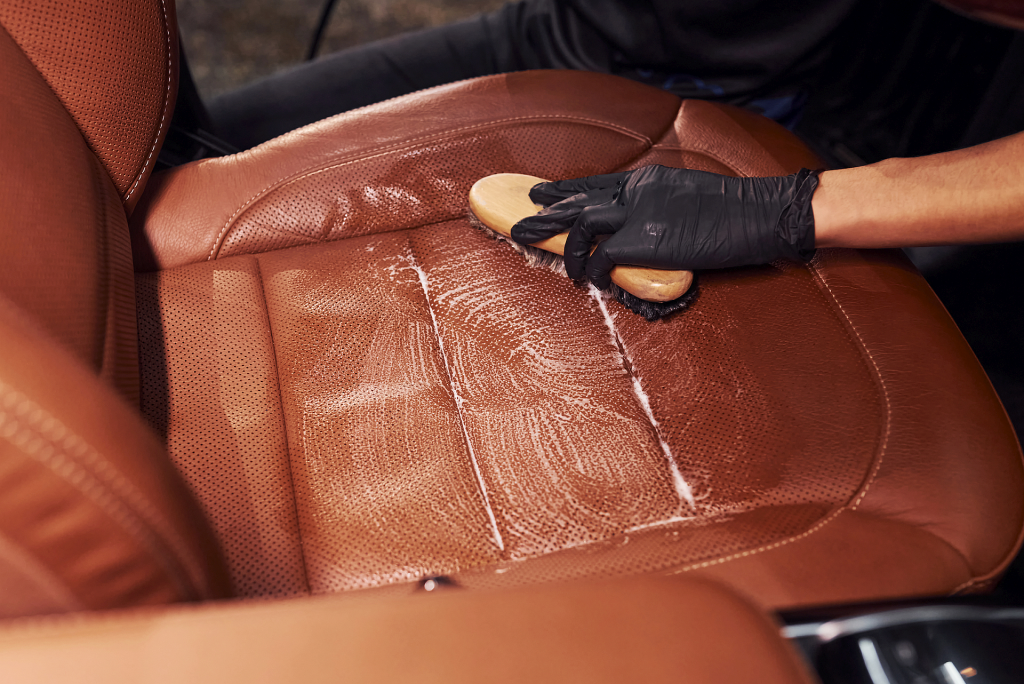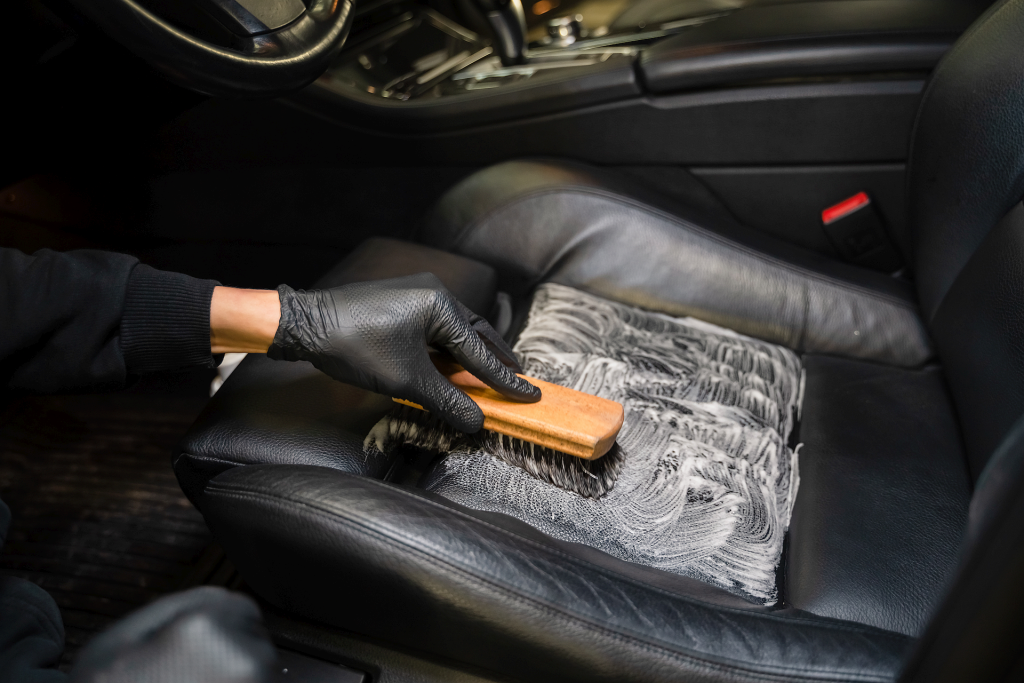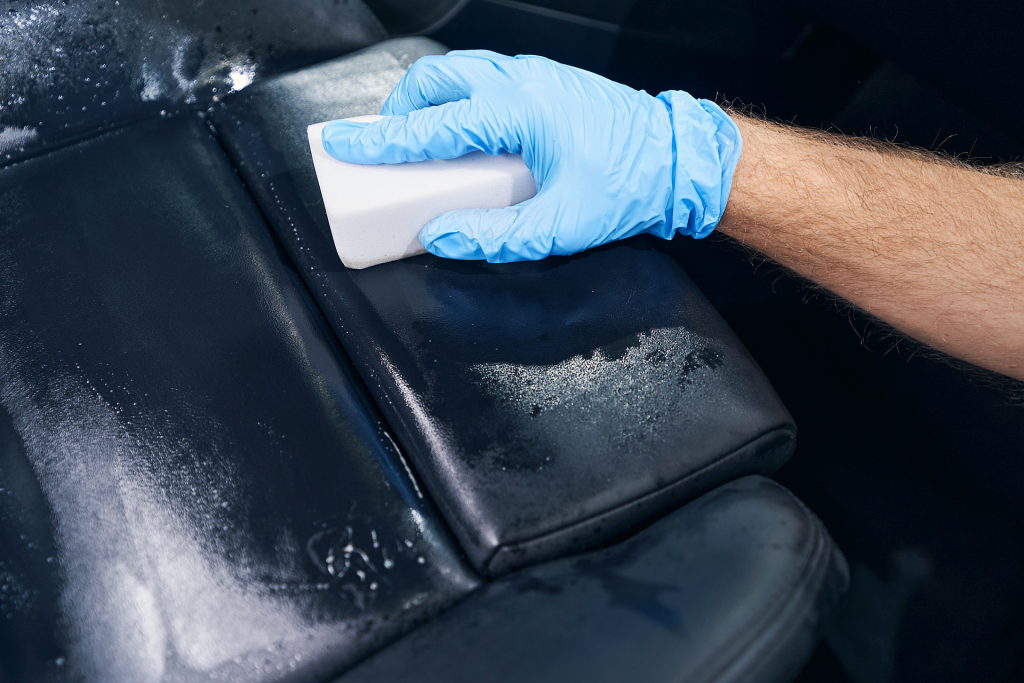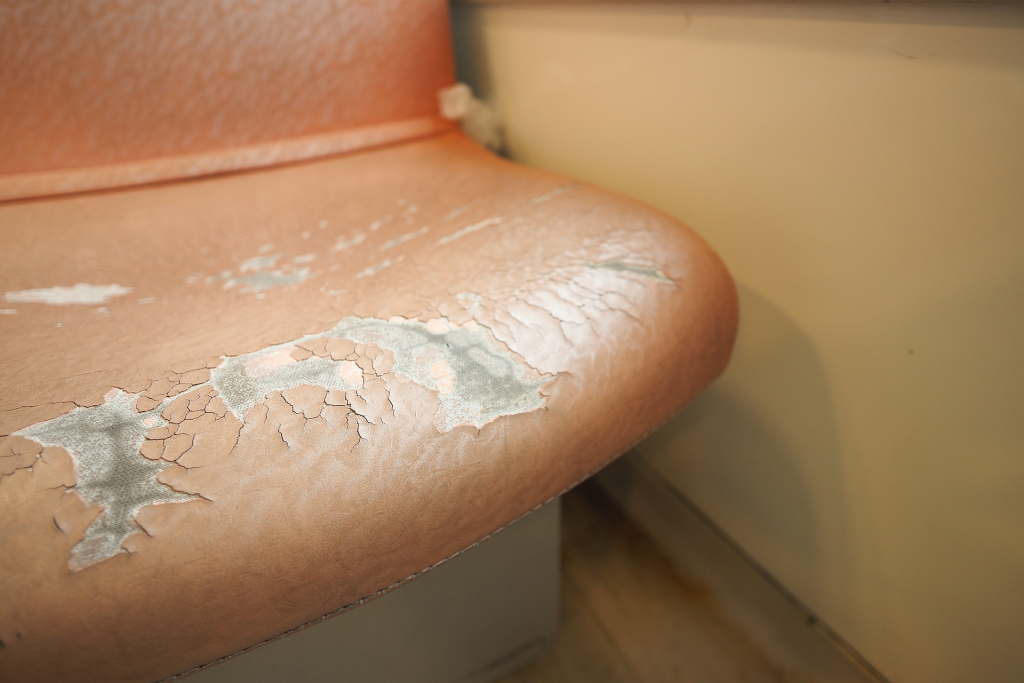Car Leather Upholstery: Revive Your Luxury Seats Now

Leather car seats are more than just a stylish feature—they’re an investment in your car’s comfort and value. But without proper care, they’re prone to cracking, fading, and general wear and tear. Regular maintenance not only keeps them looking great but ensures they last for years. In this guide, you’ll learn practical tips to protect your leather seats from damage, retain their softness, and preserve their luxurious look. Whether your goal is to clean, condition, or simply prevent deterioration, this step-by-step approach will help you maintain leather’s beauty and functionality with ease.
Understanding Your Leather Seats

Leather car seats add a touch of luxury and comfort to your vehicle, but they also come with some unique care requirements. To protect your investment, it’s important to understand the materials and types of leather used in car upholstery. This knowledge allows you to choose the proper cleaning methods and maintain the quality of your seats over time.
Types of Leather Used in Car Seats
Not all leather is the same, and the type used in your car’s interior plays a significant role in how you maintain it. Here are the most common leather types you’ll encounter:
- Aniline Leather
This type is the most natural and luxurious, showcasing the leather’s organic texture and imperfections. It’s soft and breathable but lacks protective coatings, making it highly susceptible to stains, fading, and scratches. - Semi-Aniline Leather
A middle ground between full aniline and coated leather, this type has a light layer of protection. It retains much of the natural look and feel without being
as sensitive to wear and tear. - Pigmented or Coated Leather
The most commonly found leather in vehicles, pigmented leather has a finished surface that increases durability and simplifies maintenance. While it doesn’t feel as natural, its protective coating resists stains and fading, making it perfect for daily use.
Knowing what type of leather you’re dealing with helps you tailor your care routine. For example, uncoated leather demands extra caution when applying cleaners, while coated leather can tolerate more robust cleaning products.
Common Leather Challenges
Even the most durable leather seats face certain challenges over time. To keep your seats looking new, it’s helpful to anticipate and address these issues:
- Cracking and Dryness
Leather naturally loses its moisture without regular conditioning, leading to cracks and a rough texture. This is especially common in climates with low humidity or extreme heat. - Fading and Discoloration
UV rays are a major enemy of leather. Prolonged sun exposure can bleach the color, leaving your seats looking dull or uneven. - Staining from Spills
Leather absorbs liquids fast if it’s not treated with a protective finish. Oily stains from food, drinks, or skincare products are particularly difficult to remove. - Scratches and Abrasions
Everyday items like car keys, bags, and even denim can scratch the leather’s surface. Once scratched, it’s hard to restore leather to its pristine condition without professional repair.
Recognizing these common issues ensures you can prevent damage rather than deal with costly fixes later.
Why Maintenance Matters for Leather Seats
Skipping regular leather care can lead to deteriorated seating that feels uncomfortable and reduces the overall value of your car over time. Here’s why staying proactive about maintenance is worth the effort:
- Preserve Aesthetic Appeal: Keeping your seats clean and conditioned enhances the luxurious appearance of your vehicle’s interior.
- Extend Lifespan: Proper care ensures the leather remains supple and durable, resisting wear for years to come.
- Retain Resale Value: Well-maintained seats can significantly boost your car’s resale or trade-in value. Nobody wants to buy a car with worn, cracked seats.
- Prevent Expensive Repairs: Replacing or reupholstering leather seats is costly, so routine maintenance is a smart way to avoid unnecessary expenses.
By understanding what causes leather to age prematurely and knowing the specific type of material you’re working with, you’ll have an easier time creating a care routine that fits your needs.
Cleaning Your Leather Car Seats Properly

Properly caring for your leather car seats takes more than just a quick wipe-down. To truly preserve their softness, color, and durability, you need a systematic approach that minimizes damage and enhances their natural beauty. Let’s look at the key steps for cleaning your leather car seats the right way.
Vacuuming and Preparing the Surface
Before applying any cleaner or conditioner, it’s essential to prepare your seats by removing debris. Why? Small particles, like sand or dirt, can act like sandpaper and scratch the leather during cleaning.
Start with a vacuum cleaner equipped with a soft brush attachment. This tool helps lift dirt without damaging the leather surface. Focus on seams, stitching, and crevices where dirt tends to accumulate. If your vacuum has a narrow nozzle attachment, use that to get into tight spaces. To remove stubborn bits, consider using a soft-bristled detailing brush. It loosens trapped particles effectively while being gentle on the leather.
A clean surface is critical; any debris left behind can interfere with the cleaning process or leave permanent scratches.
Choosing the Right Cleaner
Not all cleaning products are safe for leather. Using the wrong one, like household cleaners or vinegar, can strip the leather’s natural oils and protective coatings, leaving it brittle and damaged.
Always use a pH-balanced leather cleaner designed specifically for automotive leather. These products clean effectively without harming the material. Avoid cleaners containing harsh chemicals, ammonia, or alcohol. For best results, test your cleaner on a small, hidden area before applying it broadly. This ensures it won’t cause discoloration or a reaction with your seat’s finish.
If you’re unsure about a product, look for labels that specify compatibility with your type of leather—whether coated, semi-aniline, or perforated. This step not only keeps your leather safe but also ensures long-term protection.
Wiping and Scrubbing Techniques
The method you use to clean is just as important as the products. Using the wrong technique can do more harm than good.
- Start with a damp microfiber cloth to wipe down the surface. Microfiber is ideal because it’s non-abrasive and soft, ensuring you don’t leave scratches or lint behind.
- For tougher grime, use a soft-bristled brush soaked in your leather cleaner. Apply light pressure and clean in gentle, circular motions. This helps lift dirt without damaging the leather’s surface or protective coating.
Be mindful of perforated leather, often found in ventilated seats. Avoid saturating the material with moisture to prevent liquid from seeping into the perforations. Instead, use minimal product and dab rather than scrub.
After scrubbing, wipe away excess cleaner immediately with a clean microfiber cloth to prevent buildup or streaking.
Drying and Inspecting the Leather
Once the cleaning step is done, don’t rush into conditioning. Drying your seats properly is a step you can’t skip.
Allow the leather to air-dry naturally—don’t use a heat source like a blow dryer, as it can dry out the material prematurely, leading to cracks. If you’re in a hurry, pat the seats lightly with a dry microfiber cloth to help absorb excess moisture.
When the seats are dry, inspect them carefully. Look for any lingering stains or spots you may have missed during the initial cleaning. Stains that remain may require a second attempt with targeted cleaning. Address these areas promptly to avoid permanent discoloration or marks.
By taking these steps, you’ll have a solid foundation for maintaining your leather seats and keeping them looking as luxurious as the day you got your car.
Conditioning and Protecting Leather Seats

Caring for your leather car seats doesn’t end with a good cleaning. Conditioning and protecting them is a critical step that ensures they stay soft, supple, and resistant to damage over time. Without it, leather can dry out, crack, or lose its luxurious appearance. With a few easy steps, you can keep your seats in top condition, whether you’re dealing with frequent use or harsh sun exposure.
How to Apply a Leather Conditioner
Conditioning keeps leather soft and prevents it from drying out and cracking. To do it right, you’ll need a high-quality conditioner specifically made for car leather. Look for products with essential oils, Vitamin E, or lanolin, which help restore moisture and maintain the leather’s natural flexibility.
Here’s how to apply it:
- Choose the right product: Avoid conditioners that contain silicone or petroleum-based ingredients, as they can build up on the leather over time and damage it. Stick to a cleaner and conditioner that’s pH balanced and safe for your type of leather (coated, semi-aniline, or aniline).
- Test the product: Before applying conditioner all over, do a patch test in an inconspicuous spot. This ensures the product won’t cause discoloration.
- Work in sections: Use a clean, soft microfiber cloth or applicator pad. Apply a small amount of conditioner in circular motions to a small section of the seat.
- Let it absorb: After applying, give the conditioner a few minutes to soak into the leather. This step ensures the natural oils penetrate deeply, rejuvenating the material.
- Buff the surface: Finish by lightly buffing the area with a dry microfiber cloth. This removes any excess product and leaves the leather looking smooth and even.
How often should you condition your seats? Aim to apply conditioner every 3-6 months depending on your climate and how heavily the seats are used.
Using Leather Sealants for Extra Protection
Concerned about sun exposure or wear caused by frequent use? A leather sealant provides an additional protective layer beyond what conditioning can achieve. While not mandatory, sealants are particularly useful if your car is regularly exposed to sunlight or if kids and pets add extra wear and tear.
When using a leather sealant:
- Choose the right product: Look for a sealant specifically designed for automotive leather. These products act like a shield, protecting against UV rays, stains, and abrasion. Products like ceramic-based leather coatings offer excellent durability.
- Apply it properly: Start by making sure your seats are freshly cleaned and conditioned. Use a microfiber pad to spread the sealant evenly across the leather. Apply it in thin layers to avoid buildup.
- Let it cure: Most sealants need time to fully cure—check the product guidelines for specifics. This often means leaving the car in a shaded or covered area where the product can bond fully with the leather.
Sealants don’t need to be applied as often as conditioners. Depending on the product, a single application can last anywhere from 6 to 12 months, making it a low-maintenance way to keep your seats protected.
Preventative Measures After Conditioning
Once you’ve cleaned, conditioned, and protected your leather seats, the key to long-term care is prevention. Taking a few simple steps can help extend the life of your efforts and avoid unnecessary damage.
- Use sunshades: UV rays are one of the biggest culprits in leather fading and cracking. Windshield sunshades or parking in shaded areas can go a long way in reducing sun damage.
- Avoid sharp or abrasive objects: Keys, laptops, belt buckles, and even some clothing materials can scratch leather. Be mindful of what comes in contact with your seats.
- Address spills immediately: Leather absorbs liquids quickly, especially if it’s untreated or the protective coating is wearing thin. Clean up spills with a soft cloth as soon as they happen to prevent stains.
- Invest in seat covers for high-use areas: If you frequently travel with pets or children, consider temporary seat covers to protect against scratches, spills, and messes.
- Keep the interior clean: Routine vacuuming prevents dirt and particles from embedding into the leather, which can wear it down over time.
These preventative strategies combined with regular conditioning ensure your seats will continue to look and feel amazing over the years.
Common Challenges and How to Overcome Them

Leather car seats are prized for their luxurious feel, but they present unique challenges when it comes to maintenance. Over time, stains, cracks, fading, and odors can affect their appearance and comfort. To keep your seats looking and feeling brand new, it’s important to know how to tackle these common issues effectively.
Removing Stains Without Damage
Stains are inevitable, whether it’s from spilled coffee, greasy food, or accidental pen marks. The key to removing them is acting quickly and using the right method for the type of stain without compromising the integrity of the leather.
- Ink Stains: Use a cotton swab dipped in rubbing alcohol or a commercial leather-safe ink remover. Gently dab the stain (don’t rub!) to avoid spreading it. Once the ink lifts, clean the area with a damp microfiber cloth.
- Food and Grease Stains: Sprinkle a small amount of baking soda on the area to absorb excess oil. Let it sit for several hours or overnight before brushing it off. Follow up with a pH-neutral leather cleaner.
- Liquid Spills: For quick clean-ups, blot (not wipe) the liquid using a dry, soft cloth. If the stain remains, use a leather-safe cleaner designed for your leather type—especially avoiding water on untreated leather like aniline.
Always test products on an inconspicuous area before applying them broadly. This ensures they don’t cause discoloration or leave unwanted marks. Patience is key—avoid using abrasive scrubbing techniques that can strip leather of its natural finish.
Dealing with Cracks and Fading
Cracks and fading are common in leather seats exposed to prolonged heat, sunlight, or dry conditions. While these issues may seem permanent, they can often be mitigated with proper care.
- Hydration is Essential: Cracked leather comes from dryness, so routine conditioning is critical. Use a high-quality leather conditioner containing ingredients like lanolin or essential oils to rehydrate and soften the surface. Apply conditioner at least every three months, or more frequently in hotter climates.
- Minor Repairs for Cracks: Use a leather repair kit for shallow cracks—these typically include a filler and color-matching dye. Follow the product instructions closely for best results.
- Combat Fading: Faded areas benefit greatly from leather restoration balms or color renewal products. These are formulated to refresh the original color without heavy reupholstery. For severe fading, consider professional services for matched dye treatment.
For prevention, park in shaded areas or use a sunshade to reduce direct UV exposure. Seat covers can also shield the leather from daily wear, especially if you’re traveling with kids or pets.
Neutralizing Bad Odors
Leather can absorb odors from spills, food, or regular use, leaving your car smelling less than fresh. But before reaching for strong chemicals, prioritize leather-safe solutions.
- Leather-specific Deodorizers: Products designed for leather upholstery gently neutralize odors without masking them with synthetic fragrances. Look for sprays or treatments that include natural enzymes to break down odor-causing particles.
- DIY Solutions: A simple mix of equal parts water and white vinegar can work wonders for mild odors. Lightly mist the affected area and allow it to air dry. For persistent smells, sprinkle baking soda on the seats and let it sit overnight before vacuuming it off.
- Prevent Smells Before They Happen: Address spills immediately to prevent leather from absorbing liquids. Use a clean, dry cloth to blot any wet areas, and follow up with a leather cleaner if necessary.
Ventilating your car regularly can also help reduce odor buildup. If all else fails, professional detailing services can provide deep cleaning and deodorizing treatments for long-lasting results.
By addressing these common challenges head-on and following these practical solutions, you’ll protect your investment while enjoying the comfort and beauty of your leather car seats for years to come.
FAQ: Troubleshooting Leather Care for Car Seats
Leather car seats are an incredible addition to any vehicle, offering unmatched comfort and a sleek, premium look. But, like any luxury item, they need proper care to keep them in top shape. Sometimes, even with the best intentions, things can go wrong. This FAQ section answers common issues and concerns people face when caring for leather car seats so you can protect your investment and avoid costly mistakes.
Why Are My Leather Seats Cracking?
Cracking is one of the most common issues with leather seats. It usually happens because the leather has lost its natural moisture, becoming dry and brittle over time. High temperatures, intense sunlight, or a lack of conditioning are often to blame. To prevent cracking, ensure you:
- Condition regularly: Use a high-quality leather conditioner every 3-6 months to maintain moisture and flexibility.
- Avoid heat: Keep your car parked in a shaded area or use sunshades to minimize exposure to UV rays.
- Clean properly: Avoid harsh cleaners that may strip away the natural oils in the leather.
If cracks have already appeared, you can use a leather repair kit to fill them in, although professional repairs are better for significant cracks.
What Should I Do About Fading?
Fading is another common issue, largely caused by prolonged exposure to sunlight. UV rays can bleach the natural color of your leather and leave it looking dull. To minimize fading:
- Use UV-blocking leather protectants to shield your seats from sun damage.
- Install a windshield sunshade and consider window tinting for added protection.
- Clean and condition your seats regularly to maintain a rich, even color.
For particularly faded areas, leather restoration balms or professional dye treatments can help restore the leather’s original vibrancy.
Is It Normal for Leather to Feel Sticky After Cleaning?
If your leather feels sticky after cleaning, it’s likely a sign that the wrong cleaning product was used or that residues from the cleaner weren’t thoroughly removed. Ensure you’re using a pH-balanced, automotive-specific leather cleaner and wipe away any excess with a microfiber cloth immediately after use. Moving forward:
- Avoid household cleaners, vinegar, or baby wipes as they leave unwanted residues.
- Rinse your microfiber cloth periodically when wiping to avoid reapplying leftover cleaner.
If stickiness persists, use a damp microfiber cloth to gently re-clean the area and leave it to air dry with windows down for ventilation.
How Do I Remove Stubborn Stains Without Damaging the Leather?
Stains are tricky but can be tackled with care. Whether you’re dealing with ink, food, or grease, it’s crucial to act quickly and avoid harsh methods that may damage the surface. For common stains:
- Grease stains: Sprinkle baking soda on the affected area to absorb oil, let it sit overnight, and vacuum it up.
- Ink stains: Dab a cotton swab with rubbing alcohol or a commercial leather-safe ink remover and gently treat the spot.
- Food stains: Use a mild, pH-balanced leather cleaner with a soft microfiber cloth to lift the stain.
Always test any cleaning product on a hidden area first to check for adverse reactions.
My Leather Seats Are Peeling—What Happened?
Peeling typically occurs when the clear coat or finish on the leather wears away, exposing the material to heavy wear and tear. This often happens with coated/pigmented leather that hasn’t been maintained properly. While peeling seats are hard to fully restore at home, steps you can take include:
- Cleaning and conditioning the remaining leather to avoid further damage.
- Using a leather repair kit to patch peeling areas for a temporary fix.
- Seeking professional reupholstery for high-quality, long-term repairs.
Prevent peeling by regularly conditioning your seats and using leather protectants to maintain the outer coating.
Can You Fix Scratches on Leather Seats?
Yes, scratches can usually be repaired, depending on their depth. Minor surface scratches can often be buffed out with a small amount of leather conditioner. For deeper scratches, you may need a leather filler and matching dye. Here’s how to maintain scratch-free leather:
- Keep sharp objects away: Avoid placing items like keys, bags, or tools on or near leather surfaces.
- Use protective covers if transporting pets or heavy items in your car.
For noticeable scratches, leather repair kits can be a budget-friendly solution, but professional repairs will yield the best results for severe damage.
Why Does My Leather Look Discolored After Cleaning?
Discoloration often occurs when the wrong cleaning materials are used, or when dirt and oils have deeply penetrated untreated leather. To fix this:
- Use a leather color restoration product to even out the affected areas.
- Clean seats thoroughly before applying any conditioner to avoid locking in discoloration.
- Always test products in an inconspicuous area first.
Prevention is key here—practice regular cleaning and conditioning routines to maintain an even tone across all surfaces.
How Can I Prevent Odors from Lingering in Leather Seats?
Leather is porous and can absorb odors from spills, pets, or general everyday use. To neutralize odors and keep your car fresh:
- Clean spills immediately: Wipe up any messes with a dry, soft cloth before they set in.
- Use baking soda: Sprinkle some on the seats, let it sit overnight, and vacuum it up to absorb odors.
- Opt for enzyme-based leather deodorizers designed to break down odor molecules.
Regularly ventilate your car to reduce odor build-up, and if the smell persists, consider a professional deep-cleaning treatment.
By addressing these questions and concerns, you’ll be better equipped to tackle any leather care challenges head-on, maintaining the look and feel of your car’s interior for years to come.
Conclusion
Caring for leather car seats is a straightforward process that pays off in long-term durability and luxury. Regular cleaning, conditioning, and protection not only preserve their appearance but also safeguard your investment from cracking, fading, and stains.
Start by integrating these simple care steps into your routine. Clean your seats monthly, condition them every 3-6 months, and use protective measures like sunshades or leather sealants to combat wear and UV damage. Quick action against spills and stains ensures your seats remain pristine.
Your leather seats deserve the same attention as any premium feature in your car. Taking the time to keep them soft, supple, and protected will leave your car looking and feeling great for years. Don’t wait—turn today into the day you commit to proper leather care and enjoy the luxury you invested in.
